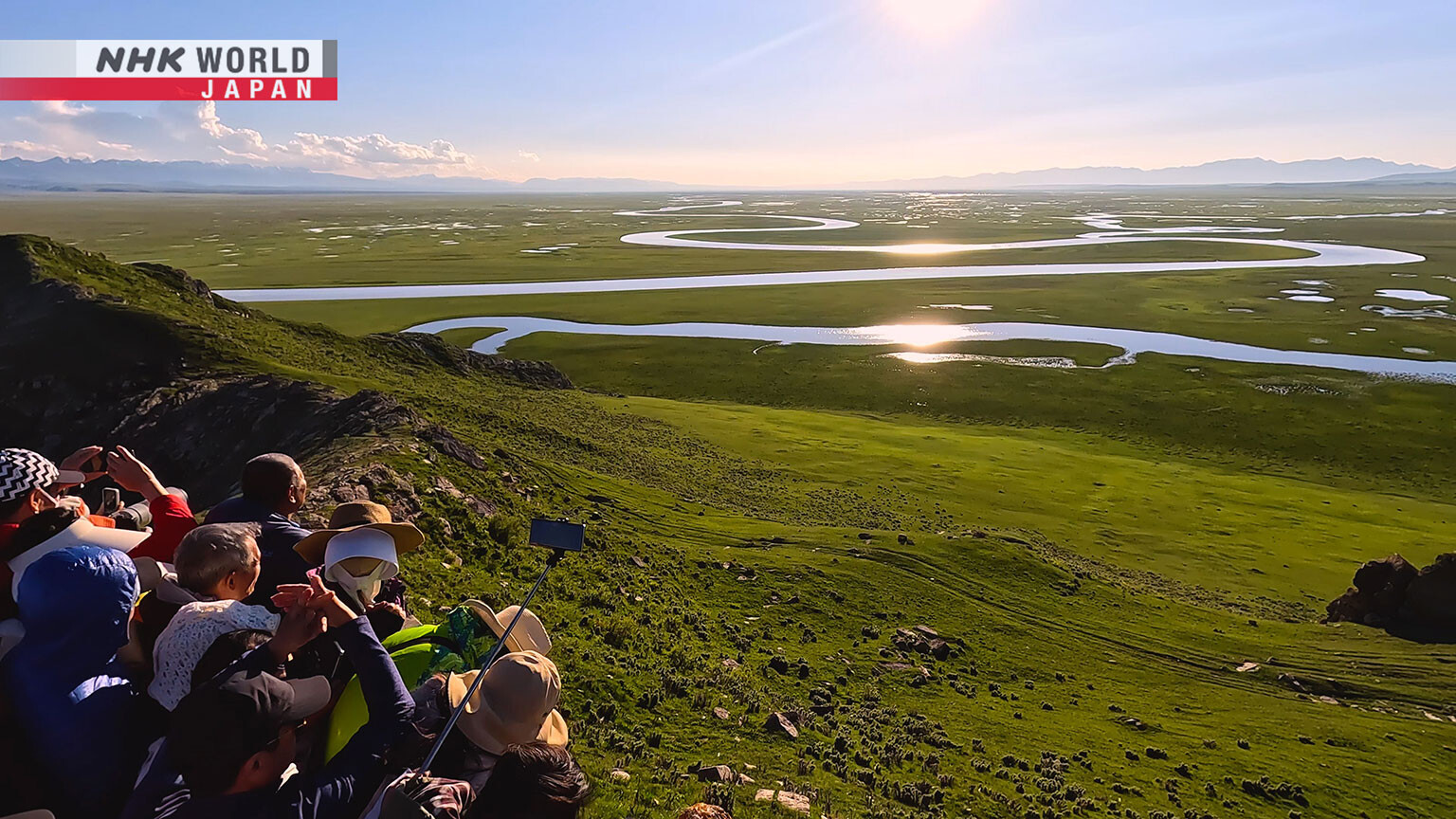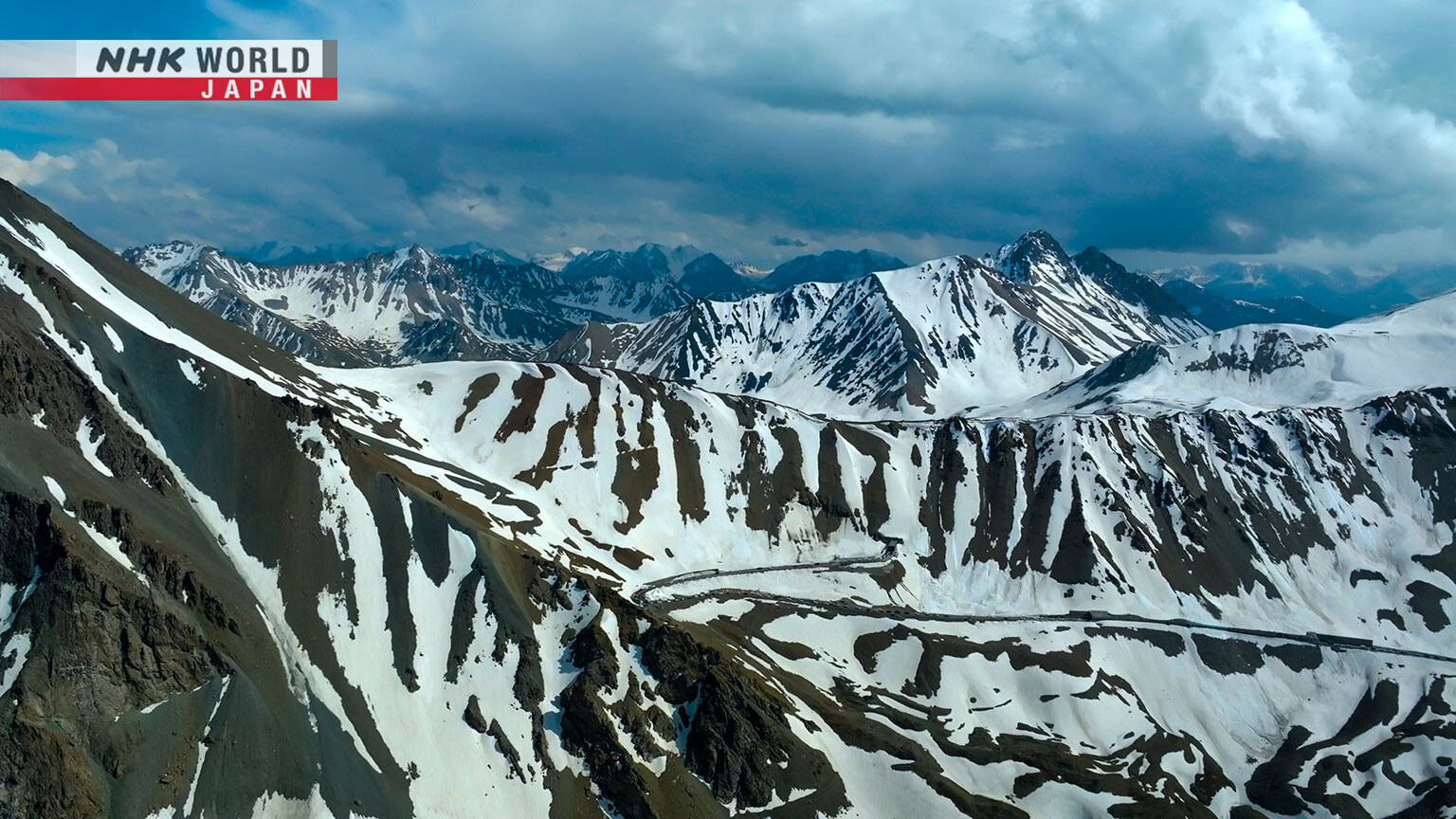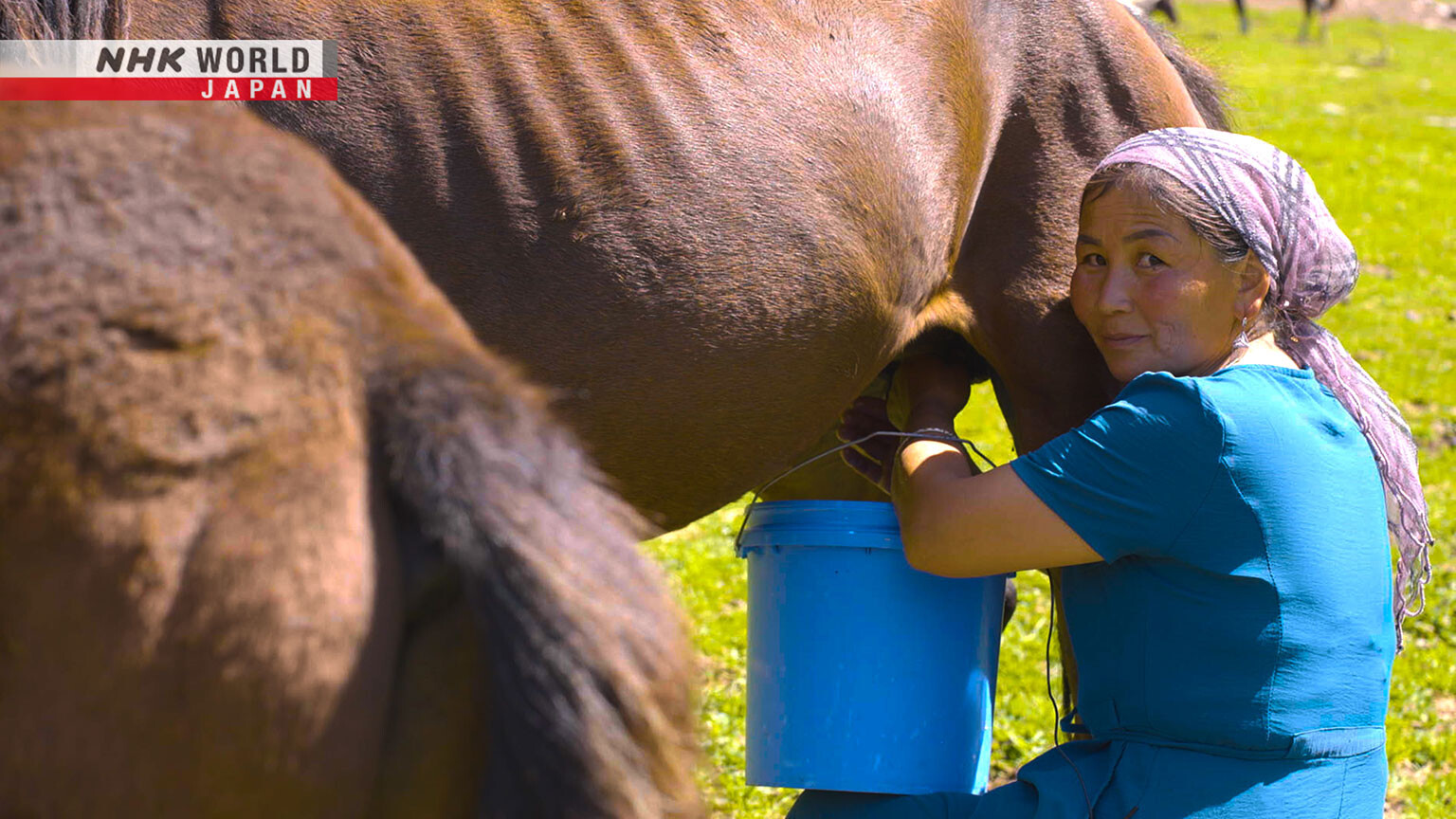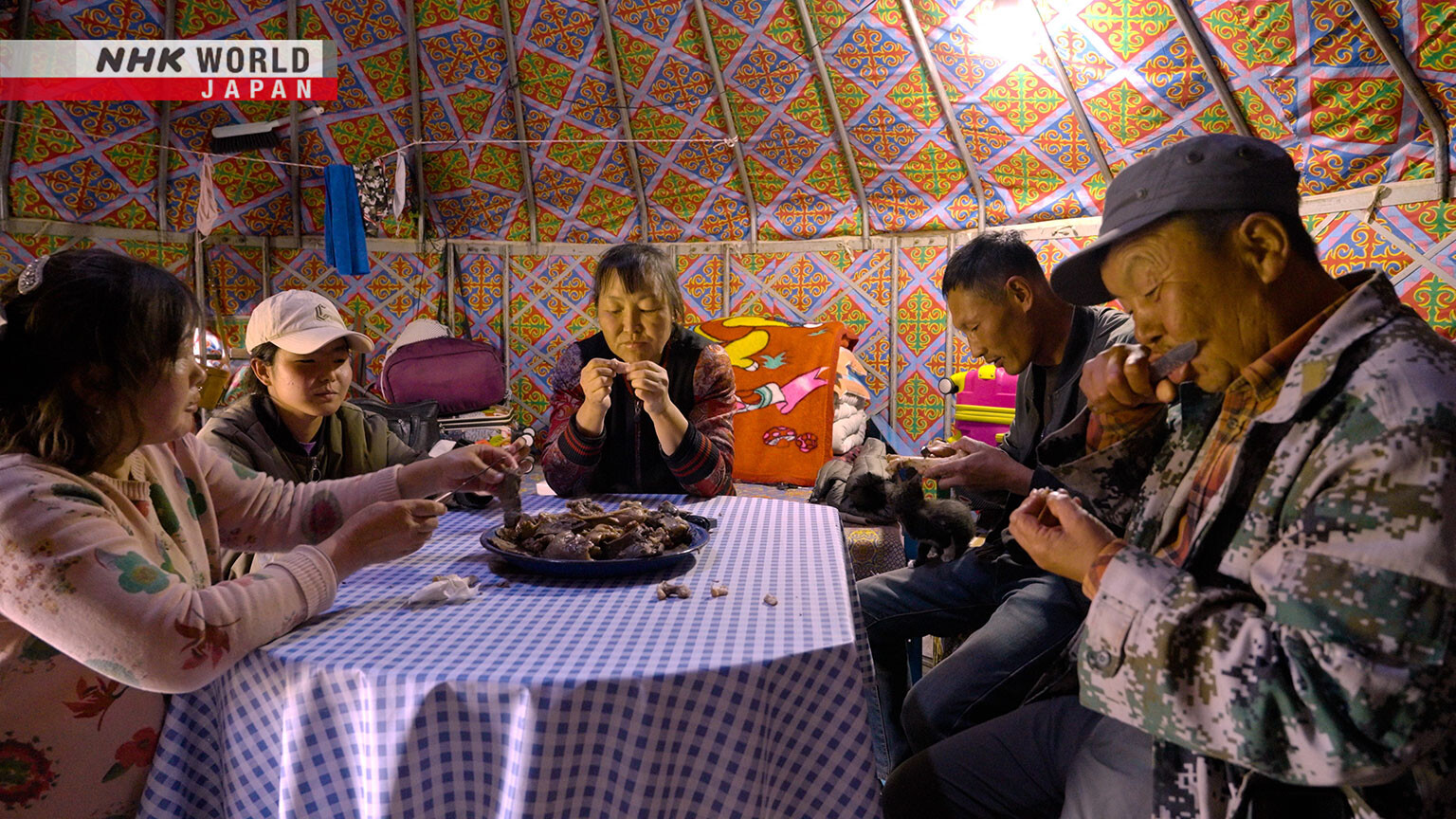China's Highway of Beauty, running through the Tianshan Mountains, reveals some of the country's most incredible natural scenery, among which diverse ethnicities of people enjoy traditional lives.




Transcript
Xinjiang, China.
One road cuts a path through the 7,000m elevation Tianshan Mountains:
Duku Highway.
Thought to lead to the most beautiful natural scenery in the nation, it's known as the
"Highway of Beauty."
Since the area is under military control, foreigners have limited access to the region.
With the assistance of the local media, we were able to document its beauty.
Along the road are countless scenes of natural splendor:
A dynamic gorge carved out by meltwater.
A peak that remains frozen even in the summer.
Lush green fields stretching as far as the eye can see.
The road is said to encompass all four of the seasons,
with weather conditions that change every 5km.
I've never experienced such high mountains
and vast plains.
Everyone should come here once.
Along the course of the road reside various ethnic groups.
The Kazakh, Uyghur, and Mongol peoples.
They live the same traditional lives that they've embraced for centuries.
Now, all that faces a major change.
We welcome the increased tourism,
but not being able to graze is hard.
We can't just give up the plains
we've lived off of for generations.
We set off on a 560km journey along the full expanse of the highway.
In this program, we introduce the breathtakingly scenic visions
and the traditional communities that we met along the way.
The journey took place in the summer of 2023.
It started from Dushanzi, a district of Xinjiang near the borders with Russia and Kazakhstan.
The central restaurants were packed with sightseers.
The Highway of Beauty is accessible only from June to October,
when the snow on the Tianshan Mountains has melted.
To glimpse this fleeting natural scenery, people flock from throughout China.
Uyghur cuisine here that serves lamb with unique seasoning is a popular local favorite.
The highway became equipped for tourists beginning in 2019.
Since then, it's become a seasonal destination to many.
We've sold more since the road improved,
around US $1,000 a day.
That's nearly twice what we used to make.
At an elevation of 400m, the start of the highway is marked here.
Each day, 20,000 vehicles travel through.
From groups of young people to families with children, the scenery attracts diverse audiences.
Some travel in the recently popular camper cars.
This family has driven from Dalian City, some 3,000km away.
My husband suggested the trip.
The road is only open
a few months a year.
I thought this would be
the perfect timing.
And so, the trip begins!
The destination awaits on the other side of the Tianshan Mountains:
Kuqa, 560km to the south.
It doesn't take long for a vast gorge to come into view.
This is the Dushanzi Canyon.
At its widest point, it stretches 1km, and reaches 200m deep.
Along the canyon wall are countless ripples in the stone.
Due to this geology, it was said to have been "carved out by the axe of the gods."
Over many years, the earth here has been gradually eroded by meltwater flowing from the mountains.
Eventually, it gave birth to this distinct backdrop.
A 40km drive from Dushanzi takes us into the mountains.
From this point on, the elevation will ascend steeply to 3,000m.
Along this grueling terrain, a father pedals a tricycle with his daughter seated on the back.
They hail from Guangzhou, a city more than 3,000km away.
The man told us that he's cycling from Dushanzi to Kuqa.
What's your name?
How old are you?
She's going to start elementary school
in September.
Before that, I wanted to show her
the Highway of Beauty.
The memories could last a lifetime.
The slope grows steadily steeper.
The sound of running water can be heard.
This is Tianpu, the sky waterfall.
Meltwater from the mountain range accumulates, and then cascades off in this downpour.
The flowing waters nurture agriculture in the foothills, supporting the lives of nearby residents.
When the road approaches an elevation of 3,000m, snow lines the ground.
Even in the middle of summer, the peaks are a world of white.
This is the highway's highest point, Haxilegen Peak.
In Mongolian, its name means "impenetrable."
Until the road was developed, passing through here was all but impossible.
I've never experienced such high mountains
and vast plains.
Everyone should come here once.
The father and daughter travelling by tricycle finally arrive after a one-and-a-half-day ride.
Aren't you cold?
She's fine.
We rode over 12 hours today.
She must be tired, but she
doesn't show it.
It's been a worthwhile experience.
They estimate that it will take more than 10 days for them to reach their destination of Kuqa.
Passing through a tunnel under the peak, we head south of the Tianshan Mountains.
After the elevation descends by around 1,000m, we reach the village of Qiaoerma.
Within the village is a large graveyard.
It serves as the resting place for 168 workers who lost their lives during construction of the highway.
For 38 years, former construction worker Chen Jungui has served as caretaker of their graves.
We worked together as comrades.
Construction of the highway began half a century ago.
In the 1960's, socialism-related disputes caused continuing tensions between China and the Soviet Union.
A number of armed conflicts occurred along the national border.
In order to effectively transport military supplies,
Chinese Chairman Mao Zedong initiated the construction of a road cutting through the Tianshan Mountains.
Over a decade, tens of thousands of soldiers were assigned to the project, and many casualties occurred.
They used to suspend workers with ropes
and attach explosives to the cliffs.
It was risky work.
While watching over his fallen comrades, Chen recalls their work together.
In the winter of 1980, as they attempted to descend from the mountain construction site,
a blizzard blocked their path, stranding them for 4 days.
Their leader made the decision to give the last food ration to Chen, the youngest worker there.
He said to me, "I won't make it."
"If you get home, please go to my hometown
and speak with my parents."
I promised him that I would.
"I'll treat them as I would my own."
He died on that mountain,
but he lives on within me.
Chen believes that the departed workers continue to watch over the safety of the highway.
Around Qiaoerma stretches an expansive plain.
Located at around 2,000m, this is the Tangbula Grassland.
Just down the highway, a herd of sheep is crossing the road.
They belong to Kazakh nomadic herders living in the area.
Their pastures continue up the foothills of the mountains.
The herd is accustomed to the steep slopes there.
One sheep lingers behind the flock.
It appears to have injured its leg.
The herder returns to give it aid.
It got bitten by a wolf.
It'll heal if treated.
Ayat herds together with his nephew Bahjan.
Every summer, they travel here from a village 150km to the west to graze their sheep.
This year, they arrived with their families just 2 days ago.
They stay in traditional tents called yurts.
Kazakhs cover their yurts with woolen cloth.
The material excels at both warmth and ventilation, making it useful in summer or winter.
Ayat's wife Paryda lends a hand.
The inside of the tent is constructed simply from wooden frames and straw sheets.
It takes them just 2 hours to ready a yurt.
A skylight exists not just to let in the light and fresh air, but to express reverence toward the heavens.
Even the national emblem of Kazakhstan includes the image of a yurt skylight.
Kazakhs hail from central Asia, but a large number came to reside here in Xinjiang.
The Kazakh Khanate was first founded in the 15th century,
in the area that corresponds to modern-day Kazakhstan.
In the early 18th century, Emperor Qianlong was crowned,
and Xinjiang was placed under Qing control at the height of the dynasty's expansion.
Some Kazakhs accepted Qing rule and relocated to Xinjiang.
It's believed that this is how their herding in the region began.
Ayat's family has conducted their grazing in these foothills for generations.
These are our grasslands. We share them
among four families.
They herd around 170 sheep and 20 cows.
From this, they gain a yearly income of about 20,000 dollars.
Life in the grasslands requires self-sufficiency.
Each summer, after the horses have finished giving birth, the herders brew a special drink.
Yeast is added to horse milk, then stirred for a full day until it ferments into alcohol.
This dairy beverage is known as Kumis.
It has a distinctly brisk, tart flavor.
In the grasslands, where fresh produce is difficult to obtain, the drink is prized as a source of vitamins and minerals.
It also strengthens the immune system.
The grasslands give us
the seeds of life.
We're grateful to nature.
However, this traditional way of life is now at risk of dying out.
Recently, the local government managing the grasslands announced that grazing there is now prohibited.
The reason behind the decree is the planned development of a large tourist facility.
A gate has already been erected, charging sightseers for entry to the land.
The Chinese government seeks to use nature-rich areas
in Xinjiang to attract both domestic and international tourism.
It didn't take long for tourists to flock to the grasslands.
Scheduled building plans include trails, restaurants, and natural hot spring facilities.
A month ago, the local government told us
it's off limits, and to go elsewhere.
But there's nowhere else suitable,
so we came back anyway.
They gave us a warning,
but what can you do?
Late June arrives.
This day is an Islamic holiday observed by Ayat and his family.
To celebrate together, fellow herders gather with them.
The year before, 30 families of herders had come together for a large and festive holiday.
This year, the majority have already given up on the profession.
We welcome the increased tourism,
but not being able to graze is hard.
If only we could coexist.
It's an appealing place for tourists,
and we should be able to make a living.
We have a deep attachment to the land.
Our families have lived here
for generations.
Even if we could no longer herd here
I'd like to live here by doing something
that would contribute to tourism.
We return to the road, at an elevation of almost 3,000m.
The weather seems to change in an instant.
What was sunny just moments ago is now enveloped in fog.
Visibility is limited to just a few meters ahead.
After passing through a tunnel, the weather grows clear once again.
With a name meaning "green valley" in Mongolian, this is the Gongnaisi Grassland.
The vast grassland borders a river flowing from the mountains into Kazakhstan.
The region is home to many ethnic Mongolians.
Mongolian herders make use of tents called "gers."
They appear very similar to the Kazakh yurts.
Recently, the implementation of solar panels has provided electricity.
We made this more than 20 years ago,
when my parents got married.
The entrance is low?
It never bothered me.
I guess it was probably a traditional
method to keep out wind and rain.
The insides of the ger differ from the yurt.
They contain a central stove as well as a bed.
Mongolians basically sleep in beds.
Parents always sleep upriver,
and their children below.
Another Mongolian tradition is music played using the tovshuur.
The dance conveys elements of local life such as herding and farming.
It even mimics the animals living on the grasslands.
Mongolians are said to have first lived here around 800 years ago.
In the 13th century, Mongolian tribes were unified under Genghis Khan.
He swiftly expanded his control toward central Asia, gaining the territory of Xinjiang.
The descendants of the Mongolian people who moved to Xinjiang in that era continue to live in the grasslands.
Progressing 100km south, vast land extends far off into the distance.
This is the second-largest grassland in China, Bayanbulak.
Since cold temperatures keep the earth frozen for most of the year, no trees grow here.
Nestled within the rich green, a town comes into view.
It too is called Bayanbulak.
The streets are filled with brand new hotels and eateries.
The town just sprouted up here suddenly.
There was nothing before,
so it's quite a change.
Come night, bright neon signs glow throughout town.
One would hardly guess they're deep amid the grasslands.
Set in the middle reaches of the Highway of Beauty, the town was developed as a major hub for tourism.
The Bayanbulak Grasslands hold another popular sightseeing location.
A huge river stretches on and on.
It's called "The Nine Turns and Eighteen Bends."
The name holds its roots in Chinese mythology.
Legend has it that once, 10 suns appeared over the earth, scorching it into a barren wasteland.
A deity known for masterful archery shot down 9 of them, saving mankind.
This river is said to be where the 9 suns fell to earth.
I wanted to photograph all nine.
I could only manage to get four.
It may be my timing.
The position of the sun affects the shot.
The Bayanbulak Grasslands have been used as a Mongolian herding site for centuries.
Sangni works herding 500 sheep in the area.
This one is a little ornery.
She was taught the ways of herding by her father Naiduman from a young age.
The wind sweeps through the grass.
We use horses to traverse it.
The air is crisp, and you can
feel each of the seasons.
I have so many fond memories
from my childhood here.
In the winter, all the grass
was covered in snow.
In the summer, I helped shear the sheep.
I'll never forget how happy I was
to be able to help my parents.
Sadly, the family's peaceful life among nature seems unlikely to continue.
The local government has marked this land for development.
Naiduman has been asked to reduce his herd of 500 sheep to just 160.
This land might be confiscated soon.
With no education, we'd have
trouble finding decent work.
It's hard for us to work
outside of herding.
This is Sangni's mother, Tuya.
Their family has lived together in the grasslands for years, but they now face a major change.
Sangni has been accepted into a university in Urumqi, and will soon be moving out.
She plans to study economics and find work at a company based in a city.
I'm most concerned that my parents
will lose their income from herding.
I need to support them.
After graduation, I'll find stable work
so they can feel secure.
This will be their last night spent under the same roof.
They dine on one of Sangni's favorite foods, salted mutton.
Neighbors drop by, and the family holds a small going-away party.
Tomorrow is a big move,
and the summer is over.
After that, you'll be headed to school.
Take good care of yourself.
I will.
It's a new life in a new city.
Stay healthy while I'm away.
Make sure you're eating well.
Don't worry.
It must be hard for her.
She's very gentle with everyone
and everything around her.
Mother, make sure to keep warm
and watch your health.
Only a short stretch of the highway remains before reaching Kuqa.
We leave the grasslands and once again enter mountainous terrain.
This is Tielimaiti, the final peak along the route.
The mountain stands at an elevation of 3,200m.
Steep slopes make for a long, winding road.
A number of hairpin curves mark the mountain as the elevation descends by 500m.
After passing the peak, a massive red mountain springs into view.
This is the Kuqa Grand Canyon, also known to Uyghur people as the "red cliff."
Its distinct coloration is the result of minerals within the rock.
Meltwater from the Tianshan Mountains
carved out this peculiar formation with a depth of 200m and length of 5km.
It's popularly known as the "Canyon of Mystery."
The road courses through the canyon, continuing south.
Drawing near to Kuqa, the earth turns a golden shade reminiscent of the Silk Road.
It's a type of earth known as yardang.
Yardang is created when abrasive winds carve protruding stones from the bedrock.
At last, the destination is in sight.
Kuqa once prospered from the Silk Road, becoming a bustling center of international trade.
The multicultural atmosphere remains a prized element of the city.
Around 80% of the residents of Kuqa are Uyghurs.
During the 9th century, their people travelled here from the Mongolian highlands to form their own kingdom.
The Silk Road connected China with Europe.
At its center was the Uyghur kingdom, with its hub in Kuqa.
Through trade with merchants bringing silk and glass, the region was prosperous through the 13th century.
The people of Kuqa continue to welcome travelers after their long trips.
Here, the Highway of Beauty comes to its end.
The curtain falls on a 560km journey.
It was very exciting.
I love Xinjiang now.
I'd like to live here.
It's so beautiful, and in a way
you can't experience elsewhere.
I was overwhelmed by the scenery.
The Highway of Beauty winds through the Tianshan mountains, connecting people of diverse ethnicities.
Along the way are countless natural wonders.
The residents living throughout continue their traditional lives while grappling with the wave of development.
Connecting with the highway,
construction of an expressway to provide greater access is planned to finish in 2026.
Over the last 10 years, more than 60,000km of road has been opened in Xinjiang.
Whether the roads may usher in fortune or adversity,
the timeless Tianshan Mountains continue to watch over travelers and residents alike.